|
|
|
|
|
 BUSSHI 仏師 OF JAPAN = SCULPTORS OF JAPAN BUSSHI 仏師 OF JAPAN = SCULPTORS OF JAPAN
Who Made Japan’s Buddha Statues?
Sculptors, Schools & Workshops
in Japanese Buddhist Statuary
ASUKA ERA, TORI BUSSHI, TORIHA SCHOOL
Before starting, please see the Busshi Index. It provides an overview of Japan’s main sculptors (Busshi) and sculpting styles, a helpful A-to-Z Busshi Index, plus definitions for essential terms and concepts. This section of our site includes 14 pages, covers 100+ sculptors, features 100+ photos, and provides the web’s first-ever integrated guidebook to Japan’s sculptors. |
|
 |
 |
 HISTORICAL SETTING. Buddhism was introduced to Japan in the mid-6th century. In subsequent decades, Buddhist images were made primarily by artisans of Korean and Chinese stock who lived in Japan. The period's mainstream works are credited to Tori Busshi 止利仏師 and his pupils, the Tori School (Toriha 止利派). Those who made Buddhist statues were known as Busshi 仏師 (literally Buddha Teacher). Tori Busshi received commissions from the Japanese imperial court and nobility, in particular the powerful Soga 蘇我 clan and Prince Shotoku Taishi 聖徳太子 (Shōtoku), and was awarded land and rank in return for his artistic talents. Bronze, not wood, was the most dominate material for making statuary during the period. HISTORICAL SETTING. Buddhism was introduced to Japan in the mid-6th century. In subsequent decades, Buddhist images were made primarily by artisans of Korean and Chinese stock who lived in Japan. The period's mainstream works are credited to Tori Busshi 止利仏師 and his pupils, the Tori School (Toriha 止利派). Those who made Buddhist statues were known as Busshi 仏師 (literally Buddha Teacher). Tori Busshi received commissions from the Japanese imperial court and nobility, in particular the powerful Soga 蘇我 clan and Prince Shotoku Taishi 聖徳太子 (Shōtoku), and was awarded land and rank in return for his artistic talents. Bronze, not wood, was the most dominate material for making statuary during the period.
TORI BUSSHI, TORI SCHOOL
- Tori Busshi 止利仏師, famed bronze sculptor of the period. Busshi is the term for Buddhist sculptor. See Glossary.
- Toriha 止利派 (Tori School); work attributed to Tori Busshi or his disciples.
- Kuratsukuri no Tori 鞍作止利. Another name for Tori Busshi, for Tori was reportedly the head of a group of Chinese craftspeople living in Japan at the time called the Kuratsukuri-be 鞍作部. According to most resources, Tori was the grandson of a Chinese immigrant named Shiba Tatsuto 司馬達等 (also read Shiba Tatto), whose clan originally made horse saddles, an art requiring knowledge of metal casting and other crafts. Other sources say Tori hailed from Korea.
- Tori Yoshiki 止利様式 (Yōshiki, Youshiki). Also written Tori Shiki 止利式. The term literally means “Tori Style.” Tori Busshi came to epitomize the art of Japan’s early Asuka Period, and statues make from his hand or by his apprentices are labeled as Tori Yoshiki or Tori Shiki. Art scholars agree that Tori-style sculpture was influenced by the Buddhist art of China’s Northern and Eastern Wei 魏 kingdoms (late 4th to 6th centuries), which was transmitted to Japan in large part by Koreans fleeing civil war on the Korean peninsula. The main stylistic elements of Asuka-period sculpture include a marked frontality (with no concern for the sides or the back of the images), crescent-shaped lips turned upward, almond-shaped eyes, and symmetrically arranged folds in the robes. The Tori style was strongly influenced by these artistic elements, which entered Japan along with the immigrants from Korea's Paekche (Jp. = Kudara 百済) and Silla (Jp. = Shinra or Shiragi 新羅) kingdoms. Nonetheless, Tori’s work commmunicates both softness and inner peace despite the stock poses, geometrical rigidity, and somewhat elongated facial and body features that characterized this period.
- Note on Korean influence. Large numbers of Koreans fled to Japan in the 6th and 7th centuries to escape incessant warring among the three Korean kingdoms of Silla (Jp. = Shiragi 新羅), Paekje / Paekche (Jp. = Kudara 百済) and Koguryo / Goguryeo (Jp. = Kōkuri 高句麗). These immigrants brought numerous Buddhist images and texts, and played major roles as Buddhist academics, teachers, sculptors, artisans, and architects. Many of Japan’s earliest temple structures were made by Korean craftsmen, for example. Click here for more on Korean influence.
|

EXTANT WORK OF THE TORI SCHOOL
-
 Tori Busshi’s signature appears on the +623 halo of the Shaka Triad, a set of three statues (cast in a single sheet of bronze ) known as the Shaka Sanzonzo 釈迦三尊像 (Sanzonzō, Sanzonzou) at Horyuji Temple 法隆寺 (Hōryūji) in Nara, one of the most prized extant bronze statues of the Asuka period. The central image of the triad was, according to many, made in the image of Prince Shotoku himself. Says JAANUS: “The statues are made of gilt bronze, and have wide-open eyes with clearly delineated lids called Kyoninkei 杏仁形 (Kyōninkei, Kyouninkei). The lips are upturned slightly in an expression known as the Archaic Smile (Kosetsu 古拙), and Shaka's robe falls in angular, stylized waves. <end JAANUS quote> The Shake Triad was cast with all attention focused on the frontal view -- little regard was given to the sides or back of the piece. Click here for more details and photos. Tori Busshi’s signature appears on the +623 halo of the Shaka Triad, a set of three statues (cast in a single sheet of bronze ) known as the Shaka Sanzonzo 釈迦三尊像 (Sanzonzō, Sanzonzou) at Horyuji Temple 法隆寺 (Hōryūji) in Nara, one of the most prized extant bronze statues of the Asuka period. The central image of the triad was, according to many, made in the image of Prince Shotoku himself. Says JAANUS: “The statues are made of gilt bronze, and have wide-open eyes with clearly delineated lids called Kyoninkei 杏仁形 (Kyōninkei, Kyouninkei). The lips are upturned slightly in an expression known as the Archaic Smile (Kosetsu 古拙), and Shaka's robe falls in angular, stylized waves. <end JAANUS quote> The Shake Triad was cast with all attention focused on the frontal view -- little regard was given to the sides or back of the piece. Click here for more details and photos.
- Asuka Daibutsu. Made of bronze, this statue is thought to be the work of Tori Busshi. The seated Asuka Daibutsu sculpture is 275.2 cm (2.75 meters) in height, and is designated an important cultural asset. Although repaired numerous times over the centuries, its elongated face and the shape of the eyes display the characteristics of the Tori-shiki 止利式 (Tori style) of Buddhist imagery shared also by the Shaka Triad at Horyu-ji Temple 法隆寺 (Hōryūji) in Nara. Click here for more details. <Source: Asuka Historical Museum>
- Guze Kannon 救世観音 (Guse, Kuze, Kuse). Also called Yumedono Kannon 夢殿観音. Most think it displays the style of Japan's Tori school of Buddhist sculpting. Today it is considered one of Japan's greatest art treasures from the early period of Buddhism in Japan. It is also widely recognized as Japan’s oldest extant wooden Buddhist sculpture. Made of camphor (kusu 樟), this gilt-wood statue was carved mostly from one piece of wood (see Ichiboku Zukuri 一木造). It displays the characteristic facial features and formalized drapery of the Tori school, but its date of construction remains unknown. No consensus has been reached as to who made it. It remained hidden from both monks and lay believerers for centuries, until it was unveiled in the late 19th century. Click here to learn more about the mystery surrounding this piece, which was reportedly made in the image of Prince Shotoku Taishi himself.
- For 50+ photos of Asuka Era Art, see Asuka Era Photo Tour

- Korean Influence. Excluding the Tori-style images of the period, other important pieces are the "seated Bodhisattva half-inclined in meditation" (Bosatsu Hankazō 菩薩半跏像) at Chūguji Temple 中宮寺, which was part of Horyu-ji Temple 法隆寺 (Hōryūji) in Nara. Statues of Miroku Bosatsu in particular were widespread during the Asuka period, and many were reproduced from Korean models. See the Asuka-Era Art Photo Tour Page for details on Korea’s influence.
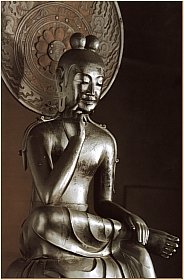 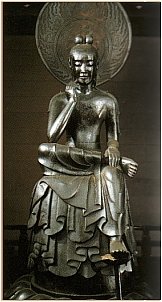
Miroku Bosatsu -- Two views of same statue
7th Century AD, Wood, 87 cm in height
Chūgūji Temple 中宮寺 (Chuguji) in Nara
  Kudara Kannon 百済観音. Most scholars believe this famous statue came from Korea or was made by Korean artisans living in Japan. The name of the statue -- Kudara Kannon 百済観音 -- literally means "Paekche Kannon." Paekche (Paekje 百済) was one of three kingdoms in Korea during this period, and Kannon is one of the most beloved Buddhist deities in Asia. The statue’s extreme thinness seems at first bizarre, but the serenity in the face and the beautiful openwork bronze in the crown are marvelous. The vase symbolizes the “nectar” of Kannon’s compassion -- it pacifies the thirst of those who pray to Kannon for assistance. There are many indications that the statue came from Korea (or was made by Korean artisans in Japan). The superior workmanship of the piece, plus many of the stylistic nuances (faint smile, slender face, thin body, folds in garment, halo) are all hallmarks of Paekche artisans and generally conform to artwork from Korea’s Three Kingdom Period. In the book Korean Impact On Japanese Culture (Korea: Hollym International Corp., 1984), authors Jon Carter Covell and Alan Covell say the foremost clue of Paekche influence is the crown's honeysuckle-lotus pattern, which can also be found among the artifacts discovered in the tomb of Paekche's King Munyong (reigned +501-523). The coiling of the vines, they say, plus the number of protrusions from the crown petals, are nearly identical to similar extant Korean pieces. Kudara Kannon 百済観音. Most scholars believe this famous statue came from Korea or was made by Korean artisans living in Japan. The name of the statue -- Kudara Kannon 百済観音 -- literally means "Paekche Kannon." Paekche (Paekje 百済) was one of three kingdoms in Korea during this period, and Kannon is one of the most beloved Buddhist deities in Asia. The statue’s extreme thinness seems at first bizarre, but the serenity in the face and the beautiful openwork bronze in the crown are marvelous. The vase symbolizes the “nectar” of Kannon’s compassion -- it pacifies the thirst of those who pray to Kannon for assistance. There are many indications that the statue came from Korea (or was made by Korean artisans in Japan). The superior workmanship of the piece, plus many of the stylistic nuances (faint smile, slender face, thin body, folds in garment, halo) are all hallmarks of Paekche artisans and generally conform to artwork from Korea’s Three Kingdom Period. In the book Korean Impact On Japanese Culture (Korea: Hollym International Corp., 1984), authors Jon Carter Covell and Alan Covell say the foremost clue of Paekche influence is the crown's honeysuckle-lotus pattern, which can also be found among the artifacts discovered in the tomb of Paekche's King Munyong (reigned +501-523). The coiling of the vines, they say, plus the number of protrusions from the crown petals, are nearly identical to similar extant Korean pieces.
Kudara Kannon, 7th Century
   Click any image to enlarge Click any image to enlarge
Hōryūji Temple 法隆寺 (Nara), H = 210 cm
Wood (Gilded Camphor 樟) with Polychromy

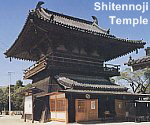  Carpenters in Asuka Period Carpenters in Asuka Period
Below text courtesy TIME MAGAZINE, Feb. 16, 2004
Of the 202 Buddhist sanctuaries in Osaka's Tennoji neighborhood, there is one that stands out: Shitennoji 四天王寺 (Shitennōji), the first Japanese temple commissioned by a royal (Prince Shotoku) and one of the oldest Buddhist complexes in Japan. Construction began in + 593, just decades after the religion reached the country's shores. One of the carpenters for Shitennoji, Shigemitsu Kongo, traveled to Japan from the Korean kingdom of Paekche (Jp. = Kudara 百済) for the project. Over a millennium-and-a-half, Shitennoji has been toppled by typhoons and burned to the ground by lightning and civil war -- and Shigemitsu's descendants have supervised its seven reconstructions. Today, working out of offices that overlook the temple, Kongo Gumi Co. is run by 54-year-old president Masakazu Kongo, the 40th Kongo to lead the company in Japan. His business, started more than 1,410 years ago, is believed to be the oldest family-run enterprise in the world. <end quote from Time Magazine>

RESOURCES
- JAANUS. Japanese Architecture & Art Net Users System. Online database devoted to Japanese art history. Compiled by the late Dr. Mary Neighbour Parent, it covers both Buddhist and Shintō deities in great detail and contains over 8,000 entries.
- Dr. Gabi Greve. See her page on Japanese Busshi. Gabi-san did most of the research and writing for the Edo Period through the Modern era. She is a regular site contributor, and maintains numerous informative web sites on topics from Haiku to Daruma. Many thanks Gabi-san !!!!
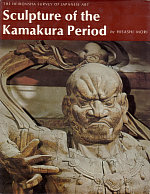  Heibonsha, Sculpture of the Kamakura Period. By Hisashi Mori, from the Heibonsha Survey of Japanese Art. Published jointly by Heibonsha (Tokyo) & John Weatherhill Inc. A book close to my heart, this publication devotes much time to the artists who created the sculptural treasures of the Kamakura era, including Unkei, Tankei, Kokei, Kaikei, and many more. Highly recommended. 1st Edition 1974. ISBN 0-8348-1017-4. Buy at Amazon Heibonsha, Sculpture of the Kamakura Period. By Hisashi Mori, from the Heibonsha Survey of Japanese Art. Published jointly by Heibonsha (Tokyo) & John Weatherhill Inc. A book close to my heart, this publication devotes much time to the artists who created the sculptural treasures of the Kamakura era, including Unkei, Tankei, Kokei, Kaikei, and many more. Highly recommended. 1st Edition 1974. ISBN 0-8348-1017-4. Buy at Amazon . .
- Classic Buddhist Sculpture: The Tempyo Period. By author Jiro Sugiyama, translated by Samuel Crowell Morse. Published in 1982 by Kodansha International. 230 pages and 170 photos. English text devoted to Japan’s Asuka through Early Heian periods and the development of Buddhist sculpture during that time. ISBN-10: 0870115294. Buy at Amazon.

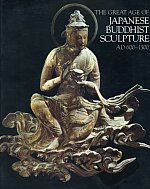  The Great Age of Japanese Buddhist Sculpture, AD 600-1300. By Nishikawa Kyotaro and Emily J Sano, Kimbell Art Museum (Fort Worth) and Japan House Gallery, 1982. 50+ photos and a wonderfully written overview of each period. Includes handy section on techniques used to make the statues. The Great Age of Japanese Buddhist Sculpture (AD 300 - 1300) The Great Age of Japanese Buddhist Sculpture, AD 600-1300. By Nishikawa Kyotaro and Emily J Sano, Kimbell Art Museum (Fort Worth) and Japan House Gallery, 1982. 50+ photos and a wonderfully written overview of each period. Includes handy section on techniques used to make the statues. The Great Age of Japanese Buddhist Sculpture (AD 300 - 1300) . .
- Comprehensive Dictionary of Japan's National Treasures. 国宝大事典 (西川 杏太郎). Published by Kodansha Ltd. 1985. 404 pages, hardcover, over 300 photos, mostly color, many full-page spreads. Japanese Language Only. ISBN 4-06-187822-0.
- Bosatsu on Clouds, Byōdō-in Temple. Catalog, May 2000. Published by Byōdō-in Temple. Produced by Askaen Inc. and Nissha Printing Co. Ltd. 56 pages, Japanese language (with small English essay). Over 50 photos, both color, B&W. Some photos at this site were scanned from this book. Of particular use when studying the life and work of Jōchō Busshi.
- Visions of the Pure Land: Treasures of Byōdō-in Temple. Catalog, 2000. Published by Asahi Shimbun. Artwork from Byōdō-in Temple. 228 pages, Japanese language with English index of works. Over 100 photos, color and B&W. Some photos at this site were scanned from this book. No longer in print. Of particular use when studying the life and work of Jōchō Busshi.
- Numerous Japanese-language temple and museum catalogs, magazines, books, and web sites. See Japanese Bibliography for extended list. Also relied on Hōryūji Temple 法隆寺 (Horyuji) catalogs and Asuka Historical Museum.

  JAPANESE WEB SITES JAPANESE WEB SITES

|
|